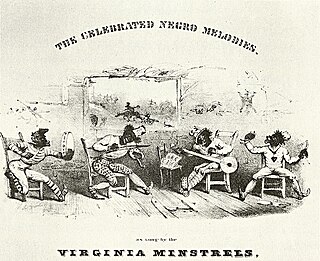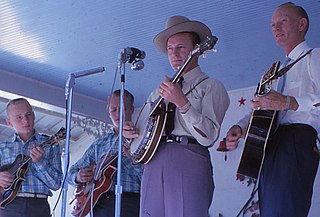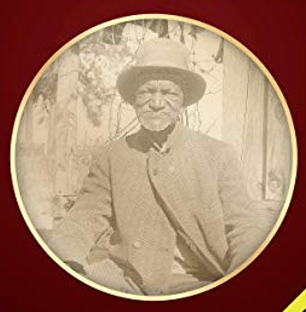Related Research Articles
The banjo is a stringed instrument with a thin membrane stretched over a frame or cavity to form a resonator. The membrane is typically circular, and usually made of plastic, or occasionally animal skin. Early forms of the instrument were fashioned by African-Americans in the United States. The banjo is frequently associated with folk and country music, and has also been used in some rock, pop and hip-hop. Several rock bands, such as the Eagles, Led Zeppelin, and The Allman Brothers, have used the five-string banjo in some of their songs. Historically, the banjo occupied a central place in Black American traditional music and the folk culture of rural whites before entering the mainstream via the minstrel shows of the 19th century. Along with the fiddle, the banjo is a mainstay of American styles of music, such as Bluegrass and old-time music. It is also very frequently used in traditional ("trad") jazz. Banjo is also a common instrument for Caribbean genres like Biguine, Calypso and Mento.

William Smith Monroe was an American mandolinist, singer, and songwriter, who created the bluegrass music genre. Because of this, he is often called the "Father of Bluegrass".
Bluegrass music is a genre of American roots music that developed in the 1940s in the United States Appalachian region. The genre derives its name from the band Bill Monroe and the Blue Grass Boys. Unlike mainstream country music, bluegrass is traditionally played on acoustic stringed instruments. Bluegrass has roots in traditional English, Scottish, and Irish ballads and dance tunes and in traditional African-American blues and jazz. Bluegrass was further developed by musicians who played with Monroe, including 5-string banjo player Earl Scruggs and guitarist Lester Flatt. Monroe characterized the genre as: "Scottish bagpipes and ole-time fiddlin'. It's a part of Methodist, Holiness and Baptist traditions. It's blues and jazz, and it has a high lonesome sound."

Earl Eugene Scruggs was an American musician noted for popularizing a three-finger banjo picking style, now called "Scruggs style", which is a defining characteristic of bluegrass music. His three-finger style of playing was radically different from the traditional way the five-string banjo had previously been played. This new style of playing became popular and elevated the banjo from its previous role as a background rhythm instrument to featured solo status. He popularized the instrument across several genres of music.

Stephen Collins Foster, known also as "the father of American music", was an American songwriter known primarily for his parlour and minstrel music. He wrote more than 200 songs, including "Oh! Susanna", "Hard Times Come Again No More", "Camptown Races", "Old Folks at Home", "My Old Kentucky Home", "Jeanie with the Light Brown Hair", "Old Black Joe", and "Beautiful Dreamer", and many of his compositions remain popular today. He has been identified as "the most famous songwriter of the nineteenth century" and may be the most recognizable American composer in other countries. Most of his handwritten music manuscripts are lost, but editions issued by publishers of his day feature in various collections.
Spirituals is a genre of Christian music that is "purely and solely the creation" of generations of African Americans, which merged African cultural heritage with the experiences of being held in bondage in slavery, at first during the transatlantic slave trade—the largest and one of the most inhumane forced migrations in recorded human history, and for centuries afterwards, through the domestic slave trade. Spirituals encompass the "sing songs," work songs, and plantation songs that evolved into the blues and gospel songs in church. In the nineteenth century, the word "spirituals" referred to all these subcategories of folk songs. While they were often rooted in biblical stories, they also described the extreme hardships endured by African Americans who were enslaved from the 17th century until the 1860s, the emancipation altering mainly the nature of slavery for many. Many new derivative music genres emerged from the spirituals songcraft.

The minstrel show, also called minstrelsy, was an American form of racist entertainment developed in the early 19th century. Each show consisted of comic skits, variety acts, dancing, and music performances that depicted people specifically of African descent. The shows were performed by mostly white people in make-up or blackface for the purpose of playing the role of black people. There were also some African-American performers and black-only minstrel groups that formed and toured. Minstrel shows lampooned black people as dim-witted, lazy, buffoonish, superstitious, and happy-go-lucky.

Louis Marshall Jones, known professionally as Grandpa Jones, was an American banjo player and "old time" country and gospel music singer. He is a member of the Country Music Hall of Fame.

Historically, slavery has been regulated, supported, or opposed on religious grounds.
Little is known about the exact origin of the music now known as the blues. No specific year can be cited as the origin of the blues, largely because the style evolved over a long period and existed in approaching its modern form before the term blues was introduced and before the style was thoroughly documented. Ethnomusicologist Gerhard Kubik traces the roots of many of the elements that were to develop into the blues back to the African continent, the "cradle of the blues". One important early mention of something closely resembling the blues comes from 1901, when an archaeologist in Mississippi described the songs of black workers which had lyrical themes and technical elements in common with the blues.

Donald Wesley Reno was an American bluegrass and country musician, best known as a pioneering banjo and guitar player who partnered with Red Smiley, and later with guitarist Bill Harrell.

Not All Who Wander Are Lost is the third solo album by American virtuoso mandolinist Chris Thile. It was released on Sugar Hill in 2001.
A work song, "Pay Me My Money Down" originated among the Negro stevedores working in the Georgia Sea Islands. It was collected by Lydia Parrish and published in her 1942 book, Slave Songs of the Georgia Sea Islands:

"Darling Nelly Gray" is a 19th-century popular song written and composed by Benjamin Hanby. It is written as from the point of view of an African-American male slave in Kentucky whose sweetheart has been taken away by slave-owners. The man mourns his beloved, who has been sold South to Georgia. He eventually dies and joins her in heaven.
A shout or ring shout is an ecstatic, transcendent religious ritual, first practiced by African slaves in the West Indies and the United States, in which worshipers move in a circle while shuffling and stomping their feet and clapping their hands. Despite the name, shouting aloud is not an essential part of the ritual.

John Jea was an African-American writer, preacher, abolitionist and sailor, best known for his 1811 autobiography The Life, History, and Unparalleled Sufferings of John Jea, the African Preacher. Jea was enslaved from a young age, and after gaining his freedom in the 1790s traveled and preached widely.
During the American Civil War, music played a prominent role on both sides of the conflict, Union and Confederate. On the battlefield, different instruments including bugles, drums, and fifes were played to issue marching orders or sometimes simply to boost the morale of one's fellow soldiers. Singing was also employed not only as a recreational activity but as a release from the inevitable tensions that come with fighting in a war. In camp, music was a diversion away from the bloodshed, helping the soldiers deal with homesickness and boredom. Soldiers of both sides often engaged in recreation with musical instruments, and when the opposing armies were near each other, sometimes the bands from both sides of the conflict played against each other on the night before a battle.
"When It's Sleepy Time Down South", also known as "Sleepy Time Down South", is a 1931 jazz song written by Clarence Muse, Leon René and Otis René. It was sung in the 1931 movie Safe in Hell by Nina Mae McKinney, and became the signature song of Louis Armstrong, who recorded it almost a hundred times during his career. The song is now considered a jazz standard and it has been recorded by a plethora of artists. A popular recording in 1931 was by Paul Whiteman and his Orchestra.
"Muskrat Ramble" is a jazz composition written by Kid Ory in 1926. It was first recorded on February 26, 1926, by Louis Armstrong and his Hot Five, and became the group's most frequently recorded piece. It was paired on the flip side with another one of Armstrong's hits, "Heebie Jeebies." It was a prominent part of the Dixieland revival repertoire in the 1930s and 1940s, and was recorded by Bob Crosby, Roy Eldridge, Lionel Hampton, Woody Herman, Muggsy Spanier, Chet Atkins, Lu Watters, the Andrews Sisters, Harry James, and Al Hirt, among others. It is considered a part of the jazz standard repertoire.
The poetry in The Lord of the Rings consists of the poems and songs written by J. R. R. Tolkien, interspersed with the prose of his high fantasy novel of Middle-earth, The Lord of the Rings. The book contains over 60 pieces of verse of many kinds; some poems related to the book were published separately. Seven of Tolkien's songs, all but one from The Lord of the Rings, were made into a song-cycle, The Road Goes Ever On, set to music by Donald Swann. All the poems in The Lord of the Rings were set to music and published on CDs by The Tolkien Ensemble.
References
- ↑ Hall, Dennis; Hall, Susan G. (2006). American Icons. Greenwood Publishing Group. p. 47. ISBN 978-0-313-02767-3.
- ↑ Walker, Janet (2001). Westerns: Films Through History. Psychology Press. p. 173. ISBN 978-0-415-92424-5.
- ↑ Starr, S. Frederick (2000). Louis Moreau Gottschalk. University of Illinois Press. p. 147. ISBN 978-0-252-06876-8.
